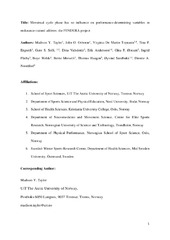| dc.contributor.author | Taylor, Madison | |
| dc.contributor.author | Osborne, John Owen | |
| dc.contributor.author | De Martin Topranin, Virginia | |
| dc.contributor.author | Engseth, Tina Pettersen | |
| dc.contributor.author | Solli, Guro Strøm | |
| dc.contributor.author | Valsdottir, Ditta | |
| dc.contributor.author | Andersson, Bror Erik Petrus | |
| dc.contributor.author | Flugstad Øistuen, Gina | |
| dc.contributor.author | Flatby, Ingrid | |
| dc.contributor.author | Welde, Boye | |
| dc.contributor.author | Morseth, Bente | |
| dc.contributor.author | Haugen, Thomas | |
| dc.contributor.author | Sandbakk, Øyvind Bucher | |
| dc.contributor.author | Noordhof, Dionne Adriana | |
| dc.date.accessioned | 2025-02-20T12:04:03Z | |
| dc.date.available | 2025-02-20T12:04:03Z | |
| dc.date.issued | 2024-09 | |
| dc.description.abstract | Female athletes frequently perceive performance changes throughout the menstrual cycle (MC). However, if and how the MC influences performance-determining variables remain unclear.<p>
<p>Purpose - This study aimed to investigate the effect of the MC and endogenous sex hormone concentrations on performance-determining variables in three distinct MC phases in endurance-trained females.<p>
<p>Methods - Twenty-one eumenorrheic trained/highly trained endurance athletes completed a standardized test battery during the early follicular phase (EFP), ovulatory phase (OP), and midluteal phase (MLP) for either one (n = 7) or two test cycles (n = 14). MC phases were determined using calendar-based counting, urinary ovulation testing, and verified with serum hormone analysis. MCs were retrospectively classified as eumenorrheic or disturbed. Disturbed MCs were excluded from analysis. The test battery consisted of 4–6 × 5-min submaximal stages with stepwise speed increases, a 30-s all-out double-poling ski ergometer test, and a maximal incremental treadmill running test.<p>
<p>Results - At a group level, there was no effect of MC phase or the serum concentrations of estrogen and progesterone on peak oxygen uptake (V̇O2peak), oxygen uptake at 4 mmol·L−1 blood lactate concentration, time to exhaustion, running economy, or mean 30-s power output (MPO30s). Serum testosterone concentration was positively associated with MPO30s (P = 0.016). Changes in V̇O2peak from EFP to MLP were inconsistent between individuals and across cycles.<p>
<p>Conclusions - None of the measured performance-determining variables were influenced by MC phase or serum estrogen or progesterone concentrations. Although some individual patterns could be observed, there was no indication that any single MC phase is consistently associated with improved or impaired V̇O2peak on a group level. | en_US |
| dc.identifier.citation | Taylor M, Osborne J, De Martin Topranin VDM, Engseth T, Solli GS, Valsdottir D, Andersson E, Flugstad Øistuen G, Flatby I, Welde B, Morseth B, Haugen T, Sandbakk Ø, Noordhof D. A.. Menstrual Cycle Phase Has No Influence on Performance-Determining Variables in Endurance-Trained Athletes: The FENDURA Project. Medicine & Science in Sports & Exercise. 2024;56(9):1595-1605 | en_US |
| dc.identifier.cristinID | FRIDAID 2261412 | |
| dc.identifier.doi | 10.1249/MSS.0000000000003447 | |
| dc.identifier.issn | 0195-9131 | |
| dc.identifier.issn | 1530-0315 | |
| dc.identifier.uri | https://hdl.handle.net/10037/36542 | |
| dc.language.iso | eng | en_US |
| dc.publisher | American College of Sports Medicine | en_US |
| dc.relation.ispartof | Taylor, M.Y. (2025). The influence of menstrual cycle phase on performance-determining variables, acute training responses and recovery in endurance-trained athletes. (Doctoral thesis). <a href=https://hdl.handle.net/10037/37185>https://hdl.handle.net/10037/37185</a> | |
| dc.relation.journal | Medicine & Science in Sports & Exercise | |
| dc.rights.accessRights | openAccess | en_US |
| dc.rights.holder | Copyright 2024 The Author(s) | en_US |
| dc.title | Menstrual Cycle Phase Has No Influence on Performance-Determining Variables in Endurance-Trained Athletes: The FENDURA Project | en_US |
| dc.type.version | acceptedVersion | en_US |
| dc.type | Journal article | en_US |
| dc.type | Tidsskriftartikkel | en_US |
| dc.type | Peer reviewed | en_US |


 English
English norsk
norsk